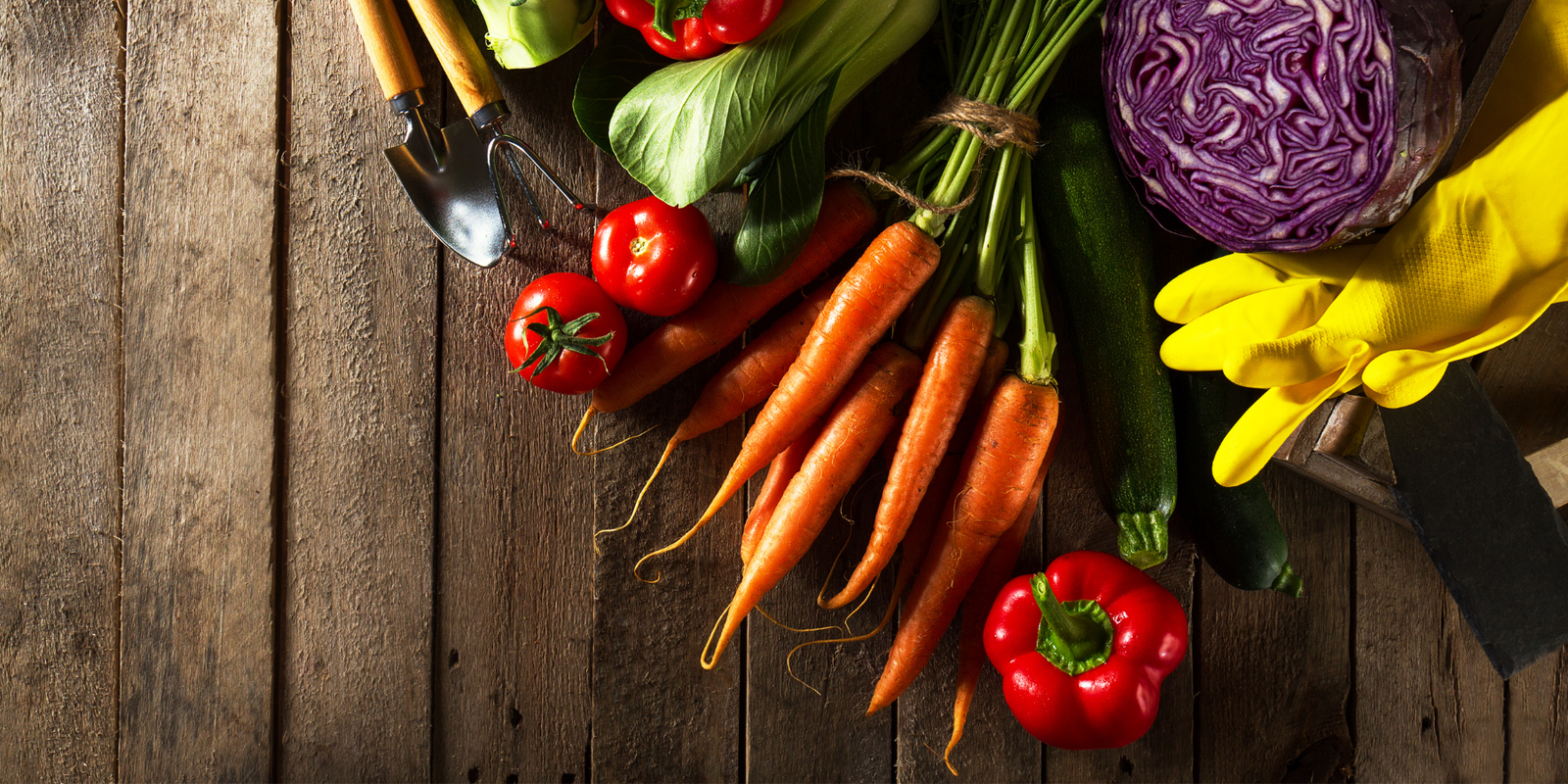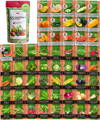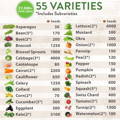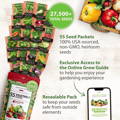
Spring
into Gardening:
Top Veggie Varieties for Your Garden
Spring is finally here and it's time to start thinking about planting your vegetable garden! There are so many different vegetable varieties to choose from, but it can be overwhelming trying to figure out which ones will work best for you. That's why we've put together a list of the top 10 must-have vegetables for your spring garden. These varieties are easy to grow, delicious, and perfect for busy gardeners who want to make the most of their time.
Tomatoes
These are the classic choice for a vegetable garden. With so many different varieties available, you can choose from small cherry tomatoes to big beefsteak tomatoes. They're perfect for sauces, salsas, salads, and more.
To plant tomatoes for spring, start by selecting a sunny location in your garden with well-drained soil. Tomatoes prefer soil with a pH of 6.0 to 7.0, so amend your soil if necessary to achieve the optimal pH level. If you're starting your tomatoes from seed, sow them indoors six to eight weeks before your last expected frost date. Once the seedlings have grown to about three inches tall, transplant them into larger containers or move them outside into the garden.

Peppers
If you love adding a little heat to your meals, peppers are a must-have in your garden. They come in a variety of heat levels, from sweet bells to blazing hots, so you can choose the perfect one for your taste.
To plant peppers for spring, start by selecting a sunny location in your garden with well-drained soil. Peppers prefer soil with a pH level between 6.0 to 7.0, so amend your soil if necessary to achieve the optimal pH level. If you're starting your peppers from seed, sow them indoors eight to ten weeks before your last expected frost date. Once the seedlings have grown to about three inches tall, transplant them into larger containers or move them outside into the garden. If you're purchasing seedlings from a nursery, be sure to choose healthy plants that are free from disease and pests. Plant the seedlings deep, burying them up to the first set of leaves, as this will encourage stronger root growth. Water your peppers regularly, ensuring the soil stays consistently moist but not waterlogged.
Peppers thrive in warm temperatures, so consider using black plastic mulch or cloches to warm up the soil and protect your plants from cold nights. As your plants grow, pinch off the top of each stem once they reach about 6-8 inches tall to encourage bushier growth and more abundant fruit production. Provide support with cages or stakes to keep the plants upright and prevent the heavy fruit from bending or breaking the stems. To prevent common pests and diseases, such as aphids or powdery mildew, avoid overcrowding your plants and rotate your crops every year. With proper care and attention, you can enjoy a flavorful and spicy harvest of peppers in the late summer and fall.

Carrots
Carrots are a sweet and crunchy addition to your garden, and they're packed with nutrients too. They're easy to grow and can be used in soups, salads, and more.
Start by selecting a sunny location in your garden with well-drained soil. Carrots prefer soil that is loose, friable, and free from rocks or other obstructions that can cause misshapen or stunted growth. If your soil is heavy or compacted, consider amending it with compost or sand to improve drainage and aeration. If you're starting your carrots from seed, sow them directly into the garden bed as soon as the soil can be worked in the spring. Plant the seeds about 1/4 inch deep and 1 inch apart, then cover with a light layer of soil. Water your carrots regularly, ensuring the soil stays consistently moist but not waterlogged.
To ensure your carrot seeds germinate properly, keep the soil moist until the seedlings emerge. Once the seedlings have grown to about 2 inches tall, thin them out to a spacing of about 2-3 inches apart. This will give each carrot enough space to grow and develop properly. To protect your carrots from pests such as carrot rust flies or root maggots, cover the bed with a floating row cover or other protective barrier. Harvest your carrots when they are of a size that is suitable for your intended use, typically about 2-3 months after planting.

Zucchini
This summer squash is a favorite among home gardeners. They're easy to grow, delicious, and perfect for stir-fries, baked goods, and more.
To plant zucchini for spring, start by preparing the soil by adding compost or well-rotted manure to improve soil fertility and structure. You can either sow zucchini seeds directly into the soil or start them indoors in peat pots, about 3-4 weeks before the last frost date in your area. When planting zucchini seeds, plant them about 1 inch deep and 3-4 feet apart to allow for adequate space for growth.
Once your zucchini plants have reached a height of about 6 inches, you can begin to fertilize them with a balanced fertilizer every 2-3 weeks to ensure they receive the necessary nutrients. It's also important to water your zucchini regularly, ensuring that the soil stays consistently moist but not waterlogged. To avoid common pests such as squash bugs and cucumber beetles, consider using row covers or insecticidal soap.

Peas
Peas are a cool-season vegetable that are great for planting in the spring. They're easy to grow and produce sweet and tender pods that are perfect for fresh eating or cooking.
To plant your peas, sow them directly into the garden bed as soon as the soil can be worked in the spring. Plant the seeds about 1 inch deep and 2-3 inches apart, then cover with a light layer of soil. Water your peas regularly, ensuring the soil stays consistently moist but not waterlogged.
To ensure your pea seeds germinate properly, keep the soil moist until the seedlings emerge. Once the seedlings have grown to about 2 inches tall, provide them with support using stakes, trellises, or netting. Peas are climbers, and they will need something to climb on in order to grow properly.
To protect your peas from pests such as birds, consider covering the bed with netting or using scare tactics such as reflective tape or fake owls. Harvest your peas when the pods are plump and full, typically about 2-3 months after planting.

Lettuce
This cool-season vegetable grows quickly in the spring, so it's perfect for a fast harvest. With a variety of colors and textures, lettuce is a great addition to your garden.
Lettuce prefers well-drained soil that is rich in organic matter and has a slightly acidic pH. If your soil is heavy or clay-like, consider amending it with compost or sand to improve drainage and aeration.
To plant your lettuce, sow the seeds directly into the garden bed about 1/4 inch deep and 1-2 inches apart. Cover the seeds lightly with soil, then water gently to moisten the soil. Lettuce seeds require consistent moisture in order to germinate properly, so be sure to water them regularly and keep the soil moist.
As your lettuce plants grow, thin them out to ensure they have enough space to mature properly. When the plants have reached a height of about 3-4 inches, you can begin to harvest the outer leaves by cutting them off with a pair of scissors. This will encourage the plant to continue producing new leaves.

Radishes
Radishes are a quick-growing vegetable that add a spicy kick to your garden. They're easy to grow and perfect for salads or as a garnish.
To plant your radish seeds, sow them directly into the garden bed about 1/2 inch deep and 1-2 inches apart. Cover the seeds lightly with soil, then water gently to moisten the soil. Radish seeds require consistent moisture in order to germinate properly, so be sure to water them regularly and keep the soil moist.
As your radish plants grow, thin them out to ensure they have enough space to mature properly. Depending on the variety, radishes can be ready to harvest in as little as 3-4 weeks after planting. To harvest your radishes, gently pull them out of the soil by the leaves.

Cucumbers
Cucumbers are a staple in most home gardens. They're perfect for making pickles or adding to salads, and they come in a variety of shapes and sizes.
To plant cucumbers for spring, select a location in your garden that receives full sun and has well-draining soil. Cucumbers prefer soil that is rich in organic matter and has a slightly acidic pH. If your soil is heavy or clay-like, consider amending it with compost or sand to improve drainage and aeration.
To plant your cucumber seeds, sow them directly into the garden bed about 1 inch deep and 2-3 inches apart. Cover the seeds lightly with soil, then water gently to moisten the soil. Cucumber seeds require consistent moisture in order to germinate properly, so be sure to water them regularly and keep the soil moist.
As your cucumber plants grow, provide them with support such as a trellis or stakes to keep the vines off the ground and improve air circulation around the plant. This can help to prevent diseases such as powdery mildew and cucumber beetle damage.

Beans are a warm-season vegetable that are great for planting in the spring. With so many different colors to choose from, they're a fun addition to your garden.
To plant your bean seeds, sow them directly into the garden bed about 1-2 inches deep and 2-4 inches apart, depending on the type of bean. Cover the seeds lightly with soil, then water gently to moisten the soil. Bean seeds require consistent moisture in order to germinate properly, so be sure to water them regularly and keep the soil moist.
Bean plants are prone to pest problems such as bean beetles and aphids. To avoid these problems, use row covers or insect netting to protect your plants.

Squash
Squash are a warm-season vegetable that are perfect for grilling, roasting, or using in soups and stews. They come in a variety of shapes and sizes, so you can choose the perfect one for your garden.
Squash can be planted as seeds or seedlings, depending on your preference. If planting seeds, sow them directly into the garden bed about 1 inch deep and 2-3 feet apart, depending on the type of squash. Cover the seeds with soil and water gently to keep the soil moist. If you choose to start with seedlings, plant them in the garden bed at the same depth as they were in their container.
As your squash plants grow, be sure to provide them with ample space to spread out. Squash plants can take up a lot of room in the garden, so plan accordingly. You can also train the vines to grow up a trellis or support structure to save space.
Squash plants are susceptible to powdery mildew and squash vine borers. To prevent these problems, be sure to water your plants at the base rather than from above, as wet leaves can contribute to powdery mildew. You can also use row covers or insect netting to protect your plants from squash vine borers.

So, there you have it, folks! These are the top 10 must-have vegetables for your spring garden. With a little time, effort, and love, you'll be enjoying delicious and nutritious veggies in no time. Happy planting!







